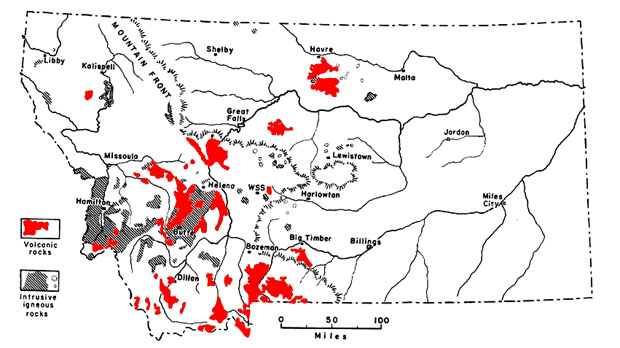|
Igneous Rocks of
Montana

There are three basic categories of rocks - sedimentary, metamorphic, and igneous. The most common type of rock found at the surface in the eastern two-thirds of Montana is sedimentary (sandstones, shales, limestone, etc.). Western Montana has the best variety, with each type present in different areas. Igneous rock is formed when magma or lava cools. The red and gray areas on the map show where igneous rock can be found at the surface, or just beneath the soil. The red areas are where lava erupted onto the
surface and hardened to form a category of
igneous rock that geologists refer to as
"extrusive" (a.k.a. volcanic). The gray areas
are where the magma hardened beneath the
surface, making a kind of igneous rock is
called "intrusive" (a.k.a. plutonic). Basalt is the most common specific type of extrusive igneous rock and granite is the most common specific type
of intrusive igneous rock.
Intrusive, or Extrusive - How can they tell? .
. .
One thing that helps geologists determine
whether an igneous rock is intrusive or
extrusive is the size of the crystals, or grains,
that makes up the rock. When lava erupts
onto the surface it tends to cool quickly,
whereas magma beneath the surface may
take centuries, or even thousands of years to harden. As a result the
various minerals in lava have little time to
organize themselves into crystals.
Consequently, extrusive rocks tend to be
fine-grained and display a more uniform color
than intrusive rocks. On the other hand, as
magma cools slowly beneath the surface,
minerals have more time to form crystals. The
crystals eventually run out of space as they
grow into each other, forming interlocking
"grains" of various colors, such as the quartz
(white), biotite (black), and feldspars (pink,
gray) that can be seem in a typical granite.
No Volcanoes - Just Left-Overs
As the map at the top of this page shows, many of the small mountain ranges in central Montana owe their existence to volcanic activity. Although some may resemble volcanic cones, they are not. Instead they are simply the eroded remains of cones and/or lava that poured onto the about 50 million years ago. Geologists refer to these areas as "volcanic fields, complexes, centers, or piles". The Bear Paws are a great example. There are no cones, just remnants volcanic activity that stand above the prairie. The photo below was taken 12 miles south of Chinook. The battlefield where Chief Joseph surrendered is shown in the foreground with the eastern edge of the Bear's Paw Mountains in the distance. Although the mountain i the photo are made of intrusive igneous rock, most of the Bear Paws consist of extrusive igneous rock.

Terms: igneous rock, plutonic rock
|



